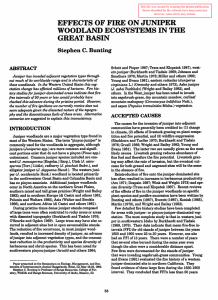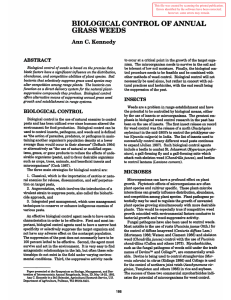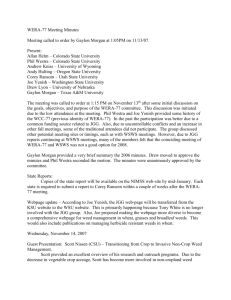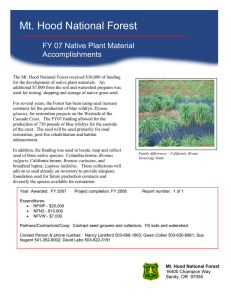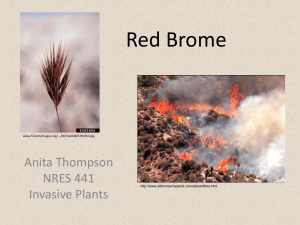A REVIEW OF THE CHEMICAL Alex G. Ogg, Jr. ABSTRACT CONTROLOFDOWNYBRO~
advertisement
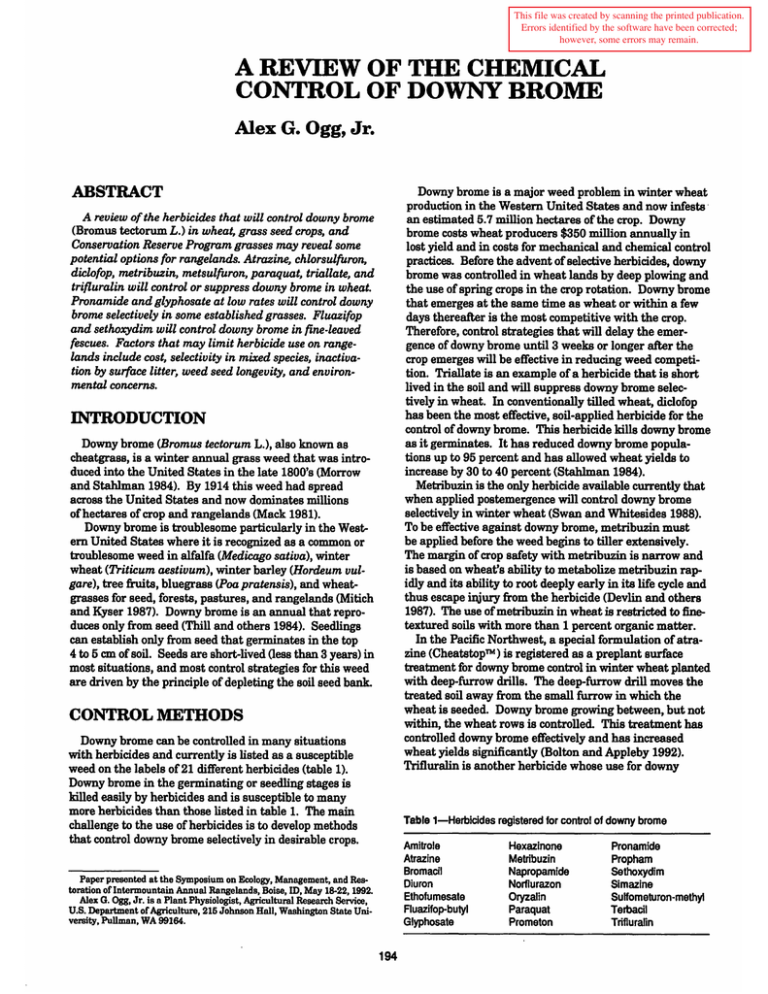
This file was created by scanning the printed publication.
Errors identified by the software have been corrected;
however, some errors may remain.
A REVIEW OF THE CHEMICAL
CONTROLOFDOWNYBRO~
Alex G. Ogg, Jr.
ABSTRACT
Downy brome is a major weed problem in winter wheat
production in the Western United States and now infests·
an estimated 5. 7 million hectares of the crop. Downy
brome costs wheat producers $350 million annually in
lost yield and in costs for mechanical and chemical control
practices. Before the advent of selective herbicides, downy
brome was controlled in wheat lands by deep plowing and
the use of spring crops in the crop rotation. Downy brome
that emerges at the same time as wheat or within a few
days thereafter is the most competitive with the crop.
Therefore, control strategies that will delay the emergence of downy brome until 3 weeks or longer after the
crop emerges will be effective in reducing weed competition. Triallate is an example of a herbicide that is short
lived in the soil and will suppress downy brome selectively in wheat. In conventionally tilled wheat, diclofop
has been the most effective, soil-applied herbicide for the
control of downy brome. This herbicide kills downy brome
as it germinates. It has reduced downy brome populations up to 95 percent and has allowed wheat yields to
increase by 30 to 40 percent (Stahlman 1984).
Metribuzin is the only herbicide available currently that
when applied postemergence will control downy brome
selectively in winter wheat (Swan and Whitesides 1988).
To be effective against downy brome, metribuzin must
be applied before the weed begins to tiller extensively.
The margin of crop safety with metribuzin is narrow and
is based on wheat's ability to metabolize metribuzin rapidly and its ability to root deeply early in its life cycle and
thus escape injury from the herbicide (Devlin and others
1987). The use of metribuzin in wheat is restricted to finetextured soils with more than 1 percent organic matter.
In the Pacific Northwest, a special formulation of atrazine (Cheatstop™) is registered as a preplant surface
treatment for downy brome control in winter wheat planted
with deep-furrow drills. The deep-furrow drill moves the
treated soil away from the small furrow in which the
wheat is seeded. Downy brome growing between, but not
within, the wheat rows is controlled. This treatment has
controlled downy brome effectively and has increased
wheat yields significantly (Bolton and Appleby 1992).
Tritluralin is another herbicide whose use for downy
A review of the herbicides that will control downy brome
(Bromus tectorum L.) in wheat, grass seed crops, and
Conservation Reserve Program grasses may reveal some
potential options for rangelands. Atrazine, chlorsulfuron,
diclofop, metribuzin, metsulfuron, paraquat, triallate, and
trifluralin will control or suppress downy brome in wheat.
Pronamide and glyphosate at low rates will control downy
brome selectively in some established grasses. Fluazifop
and sethoxydim will control downy brome in fine·leaved
fescues. Factors that may limit herbicide use on rangelands include cost, selectivity in mixed species, inactivation by surface litter, weed seed longevity, and environmental concerns.
INTRODUCTION
Downy brome (Bromus tectorum L.), also known as
cheatgrass, is a winter annual grass weed that was introduced into the United States in the late 1800's (Morrow
and Stahlman 1984). By 1914 this weed had spread
across the United States and now dominates millions
of hectares of crop and rangelands (Mack 1981).
Downy brome is troublesome particularly in the Westem United States where it is recognized as a common or
troublesome weed in alfalfa (Medicago sativa), winter
wheat (Triticum aestivum), winter barley (Hordeum vulgare), tree fruits, bluegrass (Poa pratensis), and wheatgrasses for seed, forests, pastures, and rangelands (Mitich
and Kyser 1987). Downy brome is an annual that reproduces only from seed (Thill and others 1984). Seedlings
can establish only from seed that germinates in the top
4 to 5 em of soil. Seeds are short-lived Qess than 3 years) in
most situations, and most control strategies for this weed
are driven by the principle of depleting the soil seed bank.
CONTROL METHODS
Downy brome can be controlled in many situations
with herbicides and currently is listed as a susceptible
weed on the labels of 21 different herbicides (table 1).
Downy brome in the germinating or seedling stages is
killed easily by herbicides and is susceptible to many
more herbicides than those listed in table 1. The main
challenge to the use of herbicides is to develop methods
that control downy brome selectively in desirable crops.
Table 1-Herbicides registered for control of downy brome
Amitrole
Atrazine
Bromacil
Diu ron
Ethofumesate
Fluazifop-butyl
Glyphosate
Paper presented at the Symposium on Ecology, Management, and Restoration oflntermountain Annual Rangelands, Boise,ID, May 18-22, 1992.
Alex G. Ogg, Jr. is a Plant Physiologist, Agricultural Research Service,
U.S. Department of Agriculture, 216 Johnson Hall, Washington State University, Pullman, WA 99164.
194
Hexazinone
Metribuzin
Napropamide
Norflurazon
Oryzalin
Paraquat
Prometon
Pronamide
Propham
Sethoxydim
Simazine
SuHometuron·methyl
Terbacil
Trifluralin
Table 2-lnfluence of fall-applied glyphosate + 2,4-0 1 on forage
production of wheatgrasses at Fargo, NO
Species
Cultlvar
fallow technique was developed to control downy brome
during the renovation of rangelands in Nevada (Eckert
and others 1974). Atrazine applied at 1.1 kg/ha in late
fall controlled downy brome and most other vegetation for
1 year. A significant advantage of this technique was the
accumulation of soil moisture that was available for germination and growth of perennial range grasses seeded 1 year
after the atrazine was applied. This technique required
the use of deep-furrow drills to move the treated soil away
from the seeded grasses. The furrows had an added benefit
of protecting the new seedlings from drought and coldtemperature stress. Broadleaf weeds such as Russian
thistle (Salsola iberica) and mustards (Sisymbrium and
Descurainia spp.) were controlled during the year of grass
establishment with 2,4-D. Unfortunately, the use of this
technique was limited, and atrazine is no longer registered
for use on rangelands. Since the early 1970's, several new,
highly active herbicides such as hexazinone and sulfonylureas have become available that may be adaptable to the
chemical-fallow technique of renovating rangelands.
Glyphosate is a foliage-active herbicide that will control
small downy brome at rates as low as 0.3 kg/ha. Research
in Wyoming has shown that glyphosate and paraquat applied in May at low rates controlled downy brome with
minimum injury to established range grasses (Whitson and
others 1991). To be effective, treatments had to be applied
after downy brome emergence was complete. In North
Dakota, glyphosate applied at 0.2 kg/ha in the spring did
not reduce forage production of western wheatgrass, blue
grama (Bouteloua gracilis), and Stipa spp., whereas glyphosate applied in the fall reduced forage production of
western wheatgrass (Lym and Kirby 1991). Cutlivars of
crested, western, intermediate, and thickspike wheatgrasses (Elymuslancerolatus ssp.lanceolatus) differed
greatly in response to applications of glyphosate plus
2,4-D (table 2). Therefore, any research on the tolerance
of perennial grasses to herbicides such as glyphosate needs
to include cultivars with germplasm diversity. Glyphosate
may be useful for reducing the downy brome seed bank in
rangelands and should be evaluated extensively.
.
As mentioned earlier, chlorsulfuron and metsulfuron wtll
suppress downy brome in winter wheat. Comes (198~-87),
conducting research in the low-rainfall area of Washington,
has shown that new seedings of Nordan crested wheatgrass
Forage production
Percent of nontreated
Crested
Nordan
Fairway
Parkway
Ruff
Hycrest
Westem
Walsh
Rodan
Intermediate
Mandan759R
Slate
103
46
Thickspike
So dar
Critana
135
68
76
129
91
127
93
90
68
,Giyphosate + 2,4-D applied at 0.4 + 0.7 kglha on September 19, 1989, at
Fargo, NO.
brome control in wheat is based on positional selectively.
This herbicide must be incorporated mechanically, as it
does not leach into soil. Wheat must be planted with
drills that place the wheat seed below the treated zone.
The soil-persistent sulfonylurea herbicides such as chlorsulfuron and metsulfuron applied preemergence to downy
brome have suppressed downy brome 30 to 40 percent in
winter wheat, but rates used are generally too low to control this weed consistently.
In no-till winter wheat, a granular formulation of triallate plus trifluralin (Buckle™) applied to the soil surface before planting wheat has controlled downy brome.
The granules are not absorbed by surface litter in no-till
fields and thus are more effective than liquid formulations
of these herbicides. Selective use of this treatment is dependent on some movement of the herbicide away from
the wheat row during the planting operation and on placement of the wheat seed at least 3 to 4 em deep. Diclofop
applied to the soil surface after planting wheat no-till has
controlled downy brome selectively but can be absorbed by
excessive surface residues and requires rain soon after application for activation. Under ideal conditions, weed control and crop yield response to the use of diclofop in no-till
systems can be dramatic.
Pronamide applied in late fall will control downy brome
selectively in established (1 year or older) slender wheatgrass (Elymus trachycaulus ssp. trachycaulus), tall wheatgrass (Elytrigia elongata), western wheatgrass (Pascopyrum smithii), crested wheatgrass (Agropyron desertarum), intermediate wheatgrass (Elytrigia intermedia),
creeping foxtail (Alopecurus arundinaceus), and orchardgrass (Dactylis glomerata) grown in Conservation Reserve
Program (CRP) lands. The current label for pronamide
use on CRP lands prohibits the grazing of treated grasses.
However, this herbicide may be useful in an integrated
rangeland renovation program to prevent downy brome
seed production and thus reduce the soil weed seed bank.
Downy brome is very competitive in new seedings of perennial rangegrasses and as few as 40 plants per m2 will
reduce shoot biomass of crested wheatgrass by 62 percent
(Evans 1961). In the 1970's an atrazine-based chemical
Table 3--Control of downy brome and Russian thistle in new
seedlings of Covar sheep fescue at Lind, WA
Downy
Herbicide
Rate
kglha
Nontreated
Bromoxynil
+COC2
Quizalofop
+COC
Quizalofop
+bromoxynil
+COC
brome
Russian
thistle
- - Percent control- -
Cover
sheep fescue
No.lrrfl Vigor2
0.0
.28
0
0
0
93
227
235
2.5
2.8
.11
97
0
323
3.5
.11
+.28
99
86
253
3.0
1
COC ... Crop oil concentrate (1 percent vlv).
ZVigor rating: 0 .. plants dead; 5 .. plants normal and vigorous.
195
developed must be integrated into a total rangeland system
that recognizes biological, economical, and environmental
concerns.
will tolerate preemergence applications of chlorsulfuron
applied at up to 0.05 kg/ha. Forage dry weight of crested
wheatgrass was similar to the hand-weeded controls during the year of establishment and was increased up to 200
percent during the second year when the controls were not
hand weeded. Similar results were achieved with a number of other range grasses. Davison and others {1984) reported that Nordan crested wheatgrass grown in the greenhouse would tolerate 0.16 kg/ha of chlorsulfuron applied
either preemergence or postemergence. Additional research on the use of chlorsulfuron in rangelands is needed
to determine the full potential of this and related herbicides.
REFERENCES
Bolton, F.; Appleby, A. P. 1992. [Unpublished data.]
Corvallis, OR: Oregon State University.
Comes, R. D. 1985-87. [Unpublished data.] Prosser, WA:
U.S. Department of Agriculture, Agricultural Research
Service.
Davison, J. C.; Krall, J. M.; Johnson, W. S. 1984. Theresponse of selected range grass species to chlorsulfuron.
Proceedings, Western Society ofWeed Science. 37:210.
(Abstract).
Devlin, D. L.; Gealy, D. R.; Morrow L.A. 1987. Differential metabolism of metribuzin by downy brome (Bromus
tectorum) and winter wheat (Triticum aestivum). Weed
Science. 35: 741-745.
Eckert, R. E., Jr.; Asher, J. E.; Christensen, M. D.; Evans,
R. A. 1974. Evaluation of the atrazine fallow technique
for weed control and seedling establishment. Journal of
Range Management. 27(4): 288-292.
Evans, R. A. 1961. Effects of different densities of downy
brome <Bromus tectorum) on growth and survival of
crested wheatgrass (Agropyron desertorum) in the
greenhouse.Weeds.9:216-223.
Hanks, E.; McWhorter, C. G. 1991. Variables affecting the
use of positive displacement pumps to apply herbicides
in ultralow volume. Weed Technology. 5: 111-116.
Lym, R. G.; Kirby, D. R. 1991. Effect of glyphosate on
introduced and native grasses. Weed Technology.
5:421-425.
Mack, R. N. 1981. Invasion of Bromus tectorum L. into
western North America: an ecological chronicle. AgroEcosystems. 7: 145-165.
McWhorter, C. G.; Barrentine, W. L.1988. Spread ofparaftinic oil on leaf surfaces of Johnsongrass (Sorghum
halepence). Weed Science. 36: 111-117.
Mitich, L. W.; Kyser, G. B. 1987. WSWS survey of common and troublesome weeds in twelve western states.
Proceedings, Western Society ofWeed Science. 40:
36-59.
Morrow, L.A.; Stahlman, P. W. 1984. The history and distribution of downy brome (Bromus tectorum) in North
America. Weed Science. 32(supplement 1): 2-6.
Ogg, A. G., Jr. [Unpublished data.] Pullman, WA: U.S.
Department of Agriculture, Agricultural Research
Service.
Stahlman, P. W. 1984. Downy brome (Bromus tectorum)
control with diclofop in winter wheat (Triticum
aestivum). Weed Science. 32:59-62.
Swan, D. G.; Whitesides, R. E. 1988. Downy brome {Bromus tectorum) control in winter wheat. Weed Technology. 2: 481-485.
Thill, D. C.; Beck, K. G.; Callihan, R. H. 1984. The biology
of downy brome (Bromus tectorum). Weed Science.
32(supplement 1): 7-12.
Whitson, T. D.; Fink, G. E.; Barnard, S. E. 1991. Annual
report: Rangeland research and extension demonstrations. Laramie, WY: University ofWyoming: 8-9.
RECENT DEVELOPMENTS
In recent years, a new group of herbicides has been developed that will control most annual grass weeds, including downy brome, in fine-leaved fescues. Quizalofop ap..;
plied postemergence {1990-91) at 0.1 kglha plus crop oil
concentrate controlled downy brome selectively in seedling
Covar sheep fescue (Festuca ovina) (Ogg, unpublished).
Similar results were obtained with fluazifop for barnyardgrass CEchinochloa crus-galli) control in Durar hard fescue
(Festuca trachyphylla). When these herbicides were tankmixed with bromoxynil, most seedling broadleafweeds
were controlled also (table 3). The use of these and related
herbicides needs to be investigated more fully under rangeland conditions.
Herbicide cost and sprayer efficiency are major economic
considerations in most croplands and are important especially in rangeland. Recently, a new sprayer has been developed that uses 2 to 5 L of total volume per ha (0.25 to
0.50 gallons per acre) and may enhance herbicide activity
(Hanks and McWhorter 1991). Referred to as air-assist
sprayers, these sprayers use compressed air delivered to
each nozzle at 28 to 55 k Pa (4 to 9 psi) to propel the spray
solution. Herbicides are dissolved in oil instead of water
and micro-metering pumps deliver the herbicide-oil mixture to the nozzles. Spray droplet size is maintained at
about 250 microns with this system. Because herbicides
are dissolved in oil, coverage ofleaf surfaces is improved
and spray solutions do not dry as rapidly as water-based
sprays (McWhorter and Barrentine 1988). These conditions have enhanced the activity of some herbicides. The
air-assist sprayer would appear to have excellent applicability to rangeland conditions and should be evaluated
thoroughly.
The most significant problems that need to be addressed
in the use of herbicides on rangelands include:
•
•
•
•
•
Cost of herbicides.
Selectivity in mixed species.
Inactivation of herbicides by surface litter.
Weed seed longevity.
Environmental concerns.
It should be emphasized that total reliance on one
method of control, for example herbicides, is rarely successful and is never sustainable. An approach that integrates all available methods (cultural, mechanical, biological, and chemical) is much more likely to produce effective
weed control. In addition, the weed management system
196
